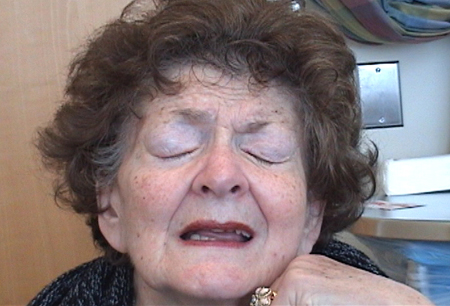Resumo
Definição
História e exame físico
Principais fatores diagnósticos
- presença de fatores de risco
- contração simultânea dos músculos agonistas e antagonistas
- dor muscular
- aparência ou agravamento de distonia com ação
- blefaroespasmo
- torcicolo cervical
- espasmos da mão
- espasmos do pé
- quadro clínico agudo (em 5 dias da exposição a um agente antidopaminérgico)
- agravamento agudo da distonia generalizada preexistente
Outros fatores diagnósticos
- torção da parte do corpo afetada
- geste antagonistique (truque sensorial)
- disseminação para outra parte do corpo
- parkinsonismo
- mioclonia
- tremor, fraqueza ou espasticidade
- exame com lâmpada de fenda com presença de anéis de Kayser-Fleischer
Fatores de risco
- história familiar de distonia
- atividade repetitiva da região afetada
- lesão no parto e desenvolvimento tardio na infância
- exposição a agentes antidopaminérgicos
- trauma
- mutação genética
- etnia judaica asquenaze
- lesão estrutural dos gânglios da base
- síndrome de Parkinson
Investigações diagnósticas
Primeiras investigações a serem solicitadas
- resposta clínica à levodopa
Investigações a serem consideradas
- ressonância nuclear magnética craniana
- ceruloplasmina sérica
- cobre urinário de 24 horas
- Testagem para o gene TOR1A (também conhecido como DYT1)
- teste genético para GCH1
Algoritmo de tratamento
reações distônicas agudas
distonia generalizada
distonia focal: além de distonia isolada no pé
distonia isolada do pé em adultos
Colaboradores
Autores
Ludy C. Shih, MD, MMSc
Associate Professor of Neurology
Department of Neurology
Boston University School of Medicine
Boston
MA
Declarações
LCS has been reimbursed by Medtronic, Praxis Precision Medicines, and WCG-Medavante for consulting services. LCS has received research grant funding from the National Institutes of Health, Abbott, and Praxis Precision Medicines.
Agradecimentos
Dr Ludy C. Shih would like to gratefully acknowledge Dr Samuel Frank, Dr David K. Simon, and Dr Daniel Tarsy, previous contributors to this topic.
Declarações
SF is employed by the Beth Israel Deaconess Medical Center, which has received funding from Allergan to support partial fellowship training. DKS has received consulting fees from the Gerson Lehrman Group. DKS is an author of a reference cited in this topic. DT has received an unrestricted grant from Allergan and Medtronic being used for education. He received unrestricted funds for patient education from Allergan, Boehringer Ingelheim, Valeant, and Teva Neurosciences. He has received research funds from Solvay and Neurogen. DT is an author of a number of references cited in this topic.
Revisores
Patricia Dowsey Limousin, MD, PhD
Reader in Clinical Neurology
Honorary Consultant
Institute of Neurology
National Hospital for Neurology and Neurosurgery
London
UK
Declarações
PDL declares that she has no competing interests.
Zhigoa Huang, MD, PhD
Assistant Professor
Director
Movement Disorder Center
Dept of Neurology
University of Florida
Tampa
FL
Declarações
ZH has been a consultant for Allergan and a speaker for Novartis and TEVA.
Créditos aos pareceristas
Os tópicos do BMJ Best Practice são constantemente atualizados, seguindo os desenvolvimentos das evidências e das diretrizes. Os pareceristas aqui listados revisaram o conteúdo pelo menos uma vez durante a história do tópico.
Declarações
As afiliações e declarações dos pareceristas referem--se ao momento da revisão.
Referências
Principais artigos
Lohmann K, Klein C. Update on the genetics of dystonia. Curr Neurol Neurosci Rep. 2017 Mar;17(3):26. Resumo
Albanese A, Asmus F, Bhatia KP, et al. EFNS guidelines on diagnosis and treatment of primary dystonias. Eur J Neurol. 2011 Jan;18(1):5-18.Texto completo Resumo
Simpson DM, Hallett M, Ashman EJ, et al. Practice guideline update summary: botulinum neurotoxin for the treatment of blepharospasm, cervical dystonia, adult spasticity, and headache. Report of the Guideline Development Subcommittee of the American Academy of Neurology. Neurology. 2016 Apr 18;86(19):1818-26.Texto completo Resumo
Artigos de referência
Uma lista completa das fontes referenciadas neste tópico está disponível para os usuários com acesso total ao BMJ Best Practice.

დიფერენციული დიაგნოზები
- Paralisia cerebral atetoide ou espástica
- Doença de Huntington (DH)
- Doença de Parkinson (DP) ou parkinsonismo atípico
Mais Diagnósticos diferenciaisგაიდლაინები
- Practice guideline update summary: Botulinum neurotoxin for the treatment of blepharospasm, cervical dystonia, adult spasticity, and headache
- EFNS guidelines on diagnosis and treatment of primary dystonias
Mais გაიდლაინებიშედით სისტემაში ან გამოიწერეთ BMJ Best Practice
ამ მასალის გამოყენება ექვემდებარება ჩვენს განცხადებას